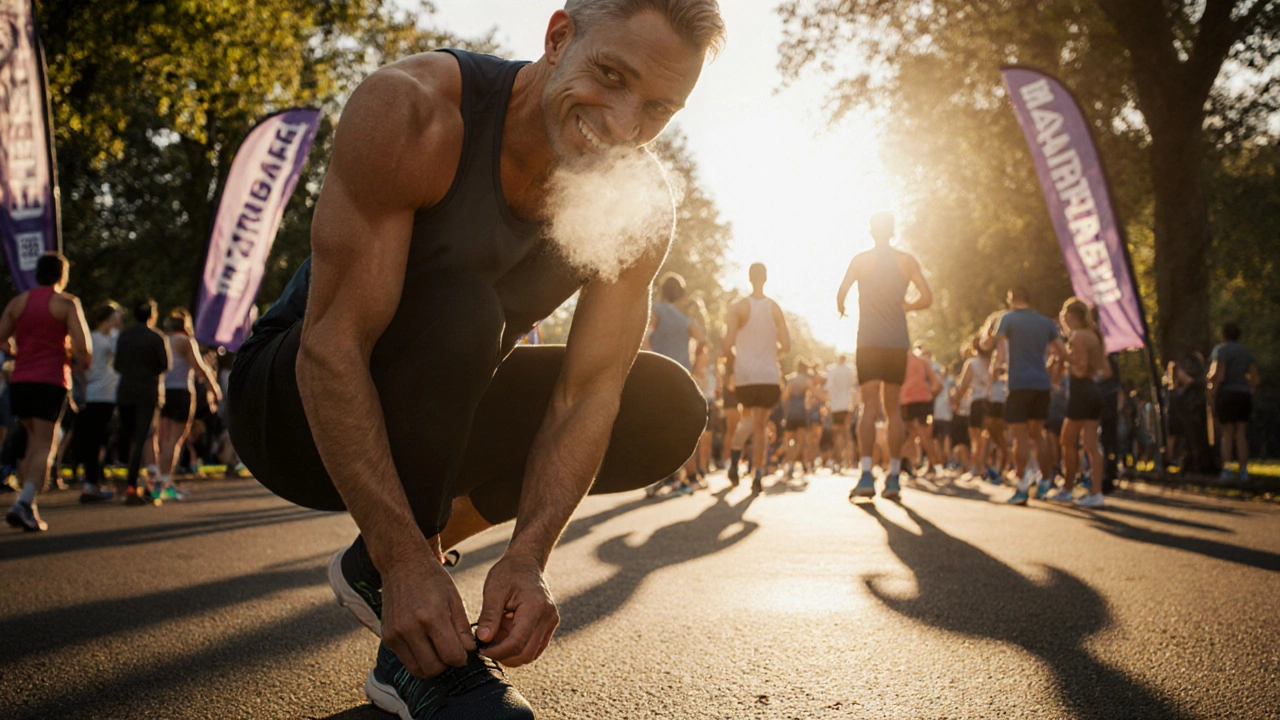Running a Marathon at 30: Is Age Really a Barrier?
 Oct, 20 2025
Oct, 20 2025
Recovery Time Calculator
How Long Should You Recover?
Based on 30+ runner training guidelines from the article
Recommended Recovery Time
0 hours
When people wonder, Marathon is a 42.195‑kilometre road race that tests endurance, strategy, and mental toughness, the answer often lands on age. Is hitting 30 a red line, or just a number you can push past with the right plan? The truth is far more nuanced, and the good news is that many 30‑year‑olds not only finish but also post personal‑best times.
Why Age Feels Like a Roadblock
Age brings three common concerns: slower recovery, higher injury risk, and a perceived loss of aerobic capacity. Scientific studies show that VO2 max - the gold‑standard measure of aerobic power - peaks in the early 20s and declines roughly 1% per year after that. VO2 Max represents the maximum amount of oxygen your body can use during intense exercise. By 30, the drop is usually small - often under 5% - and can be reclaimed with focused training.
What the Body Actually Changes After 30
Here’s the real picture:
- Muscle repair slows down: Protein synthesis declines, meaning you may need a bit more protein and slightly longer recovery between hard sessions.
- Joint resilience stays relatively stable: Unless you have chronic issues, cartilage health doesn’t sharply fall until later decades.
- Hormonal shifts: Testosterone and growth hormone levels dip gradually, affecting muscle repair and energy levels, but lifestyle can offset most of the impact.
Bottom line - the physiological changes are modest, and you can design a plan that works with them.
Designing a 30‑Friendly Marathon Plan
The core of any marathon training program is progressive overload, but for the 30‑plus runner, you add two safety nets: more recovery and smarter intensity distribution. A typical 16‑week cycle looks like this:
- Base Phase (Weeks 1‑4): 3-4 runs per week, 30‑45 minutes each, focusing on easy pace and building a consistent habit.
- Build Phase (Weeks 5‑10): Introduce a weekly long run that adds 2‑3 km each week, plus a mid‑week Tempo Run a sustained effort at a comfortably hard pace and optional hill repeats.
- Peak Phase (Weeks 11‑14): Long runs peak at 30‑32 km, incorporate a Race‑pace Run segments practiced at your target marathon speed, and keep one shorter recovery run.
- Taper (Weeks 15‑16): Cut mileage by 20‑30% each week, maintain intensity but reduce volume, allowing muscles to fully recover.
Key tweaks for the 30‑plus athlete:
- Schedule a full Recovery day focused on rest, light stretching, or low‑impact cross‑training after the longest runs.
- Use heart‑rate zones to gauge effort - keep most runs in Zone 2 (60‑70% of max HR) and reserve Zone 4 for speed work.
- Prioritize sleep - 7‑9 hours nightly improves protein synthesis and hormone balance.

Nutrition Strategies That Support Training at 30
Fueling becomes more critical when recovery windows narrow. Here are three proven approaches:
- Protein timing: Aim for 1.6‑2.0 g/kg body weight daily, split into 20‑30 g portions within an hour post‑run.
- Carb‑periodization: Load carbs (2‑3 g/kg) on days before long runs, then taper to 4‑5 g/kg on lighter days to keep glycogen stores optimal.
- Hydration & electrolytes: A 500‑ml sports drink with 200‑300 mg sodium during runs longer than an hour helps maintain fluid balance.
Supplements aren’t mandatory, but a daily creatine monohydrate dose (3‑5 g) can support muscle recovery without affecting endurance performance.
Injury Prevention: The Real Guardrails
Injuries account for the biggest dropout reason among marathon hopefuls. For a 30‑year‑old, the top three culprits are:
- Patellofemoral Pain Syndrome often called "runner’s knee" due to repetitive stress on the knee joint
- Achilles Tendinopathy degeneration of the Achilles tendon from sudden spikes in mileage
- Plantarfascial Strain inflammation of the tissue under the foot, commonly triggered by hard surfaces
Prevention tactics are simple but effective:
- Include dynamic warm‑ups (leg swings, lunges) before every run.
- Strengthen the core and hips twice a week - planks, side‑leg lifts, and single‑leg deadlifts reduce knee and hip strain.
- Upgrade to Running Shoes footwear that matches your pronation pattern and provides adequate cushioning every 500‑800 km.
- Use a foam roller or massage gun after hard sessions to keep muscle tissue pliable.

Real‑World Success Stories
Take Emma, a 32‑year‑old who started running at 27. She followed a 16‑week plan similar to the one above, added two strength sessions each week, and knocked off 20 minutes from her rookie marathon time. Or consider Carlos, 35, who returned to running after a knee injury. By focusing on low‑impact cross‑training (swimming and cycling) during his base phase, he rebuilt endurance without aggravating the joint.
These anecdotes underline a simple truth: age is a factor, but training quality, recovery, and consistency outweigh the calendar.
Quick Checklist for the 30‑Year‑Old Marathoner
| Item | Why It Matters | How to Implement |
|---|---|---|
| Weekly Mileage | Builds aerobic base | Start 30‑40 km, increase 10% per week |
| Long Run | Prepares body for distance | Progress to 30‑32 km, add a cut‑back week every 3‑4 weeks |
| Strength Training | Reduces injury risk | 2 × /week, focus on hips, core, calves |
| Recovery Day | Allows muscle repair | Full rest or gentle yoga after the longest run |
| Nutrition | Supports energy & recovery | 1.6‑2.0 g/kg protein, carb‑load before long runs |
| Sleep | Hormone regulation | 7‑9 hours/night, consistent schedule |
| Footwear | Shock absorption | Replace shoes every 500‑800 km, match pronation |
Frequently Asked Questions
Can a 30‑year‑old expect to improve their marathon time?
Absolutely. With consistent training, proper recovery, and targeted strength work, many runners shave 10‑30 minutes off a first marathon, regardless of starting age.
How many rest days should I take each week?
Aim for at least one full rest day and one easy‑run day. The rest day can be active recovery (light yoga or walking) if full rest feels uncomfortable.
Do I need a special diet to run a marathon at 30?
No exotic diet is required. Focus on balanced meals, adequate protein (1.6‑2.0 g/kg), carbohydrate timing around long runs, and staying hydrated.
Is cross‑training useful for marathon prep?
Yes. Swimming, cycling, or rowing can boost cardiovascular fitness while reducing impact stress, especially useful during base weeks.
What’s the best way to gauge effort without a smartwatch?
Use the "talk test" - you should be able to speak in short sentences during easy runs, and hold a brief conversation at marathon pace.
So, is 30 too old to run a marathon? The answer is a clear no. Your body may need a tad more care, but the fundamentals - steady mileage, smart intensity, solid recovery, and good nutrition - stay the same. Embrace the process, listen to your body, and you’ll find that the finish line is still well within reach.